King's Own Institute ACC303: Accounting Conceptual Framework Report
VerifiedAdded on 2023/05/28
|9
|1781
|131
Report
AI Summary
This report delves into the conceptual framework of accounting, examining its various components and their practical applications. The report begins by outlining the objectives of financial statements, emphasizing the needs of investors and creditors. It then explores the qualitative characteristics of useful financial information, such as relevance, materiality, and faithful representation, which are crucial for decision-making. The report also discusses the application of these concepts to a specific company, 88 Energy Limited, analyzing how the company adheres to accounting standards and manages financial risks. Furthermore, the report highlights the importance of going concern assumptions, historical cost reporting, and the recognition of revenue based on specific criteria. The conclusion emphasizes the company's compliance with accounting standards and the significance of the independent auditor's report in ensuring a fair presentation of financial information. Overall, the report provides a comprehensive overview of the conceptual framework and its practical implications for financial reporting.
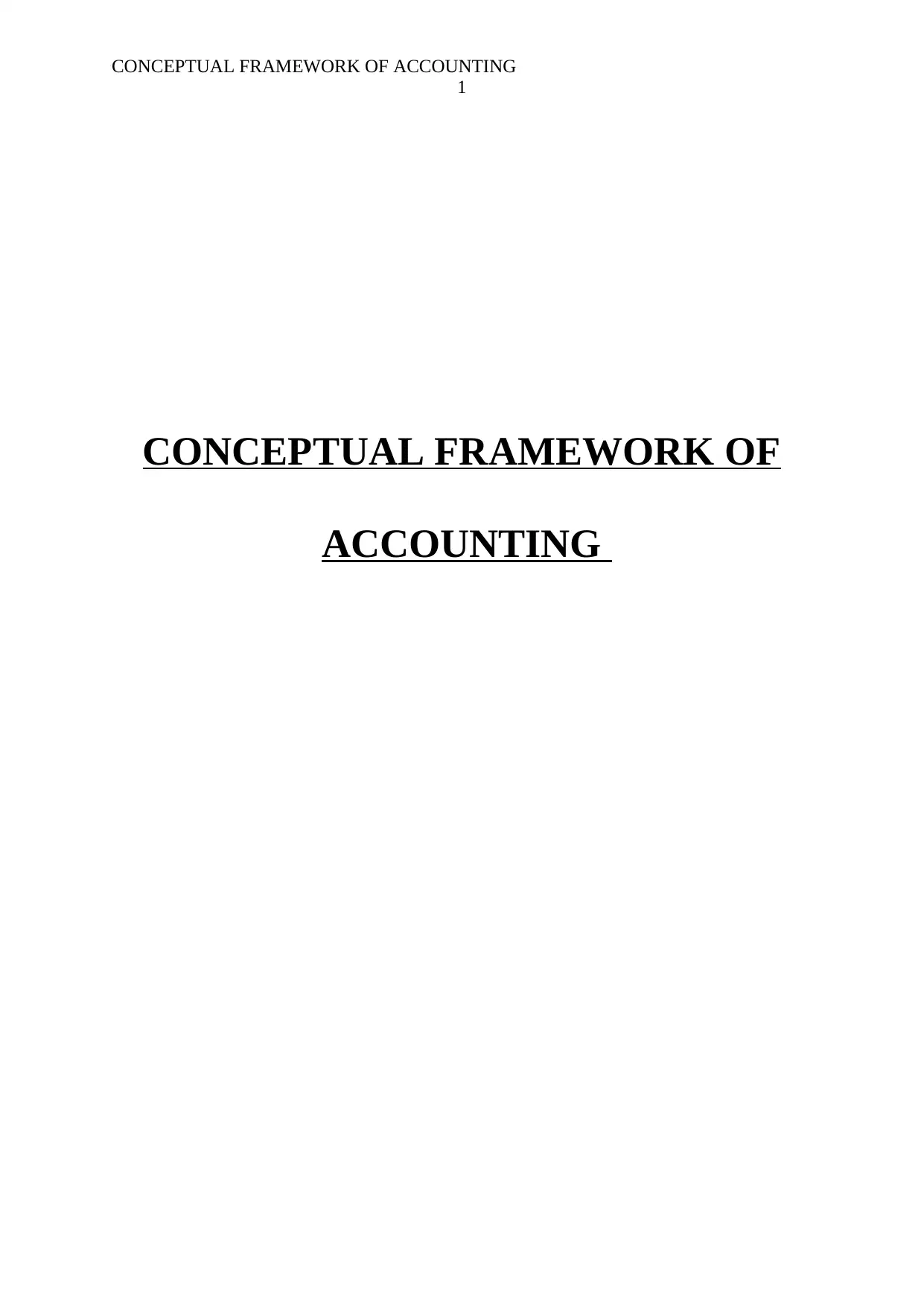
CONCEPTUAL FRAMEWORK OF ACCOUNTING
1
CONCEPTUAL FRAMEWORK OF
ACCOUNTING
1
CONCEPTUAL FRAMEWORK OF
ACCOUNTING
Paraphrase This Document
Need a fresh take? Get an instant paraphrase of this document with our AI Paraphraser
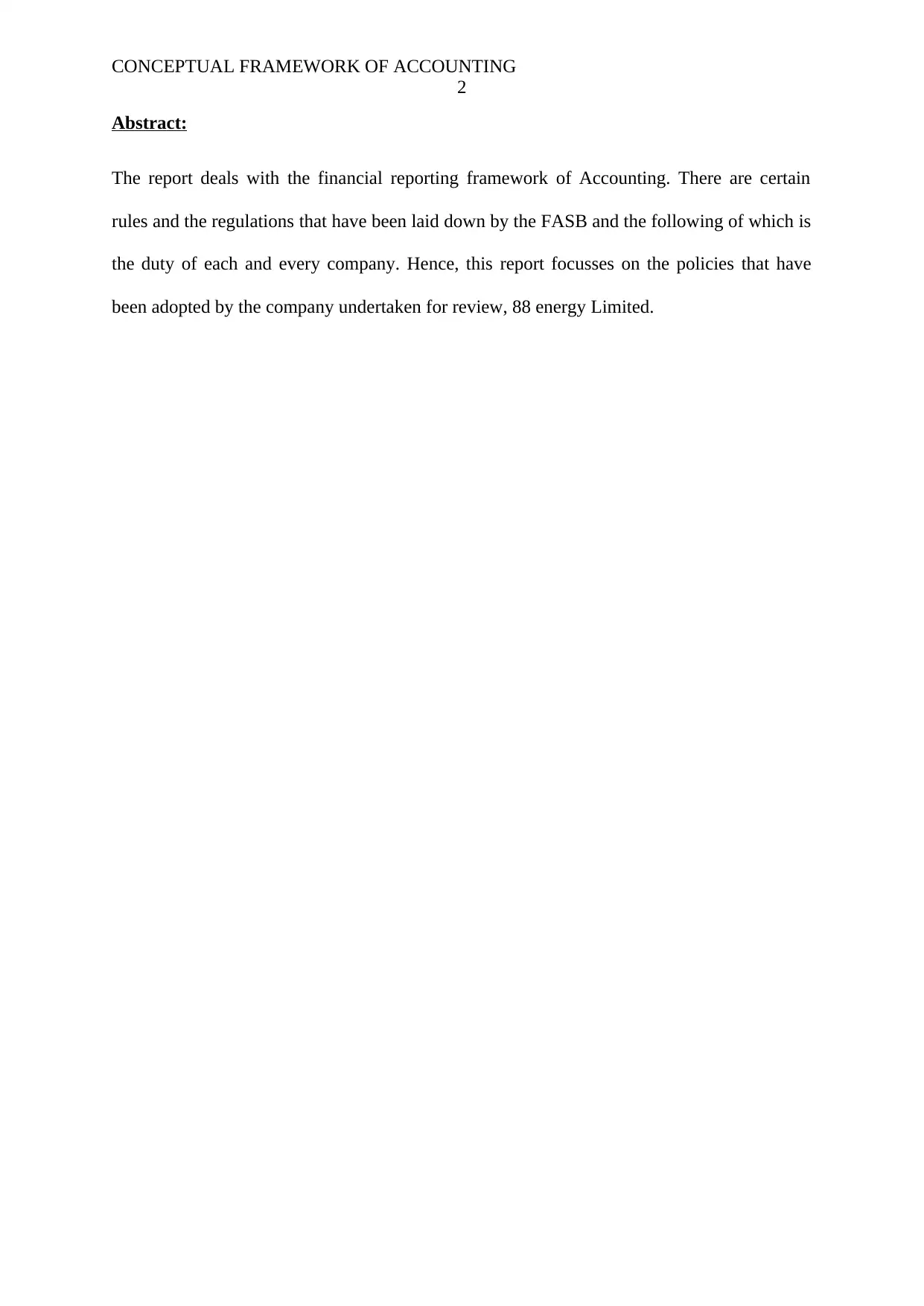
CONCEPTUAL FRAMEWORK OF ACCOUNTING
2
Abstract:
The report deals with the financial reporting framework of Accounting. There are certain
rules and the regulations that have been laid down by the FASB and the following of which is
the duty of each and every company. Hence, this report focusses on the policies that have
been adopted by the company undertaken for review, 88 energy Limited.
2
Abstract:
The report deals with the financial reporting framework of Accounting. There are certain
rules and the regulations that have been laid down by the FASB and the following of which is
the duty of each and every company. Hence, this report focusses on the policies that have
been adopted by the company undertaken for review, 88 energy Limited.
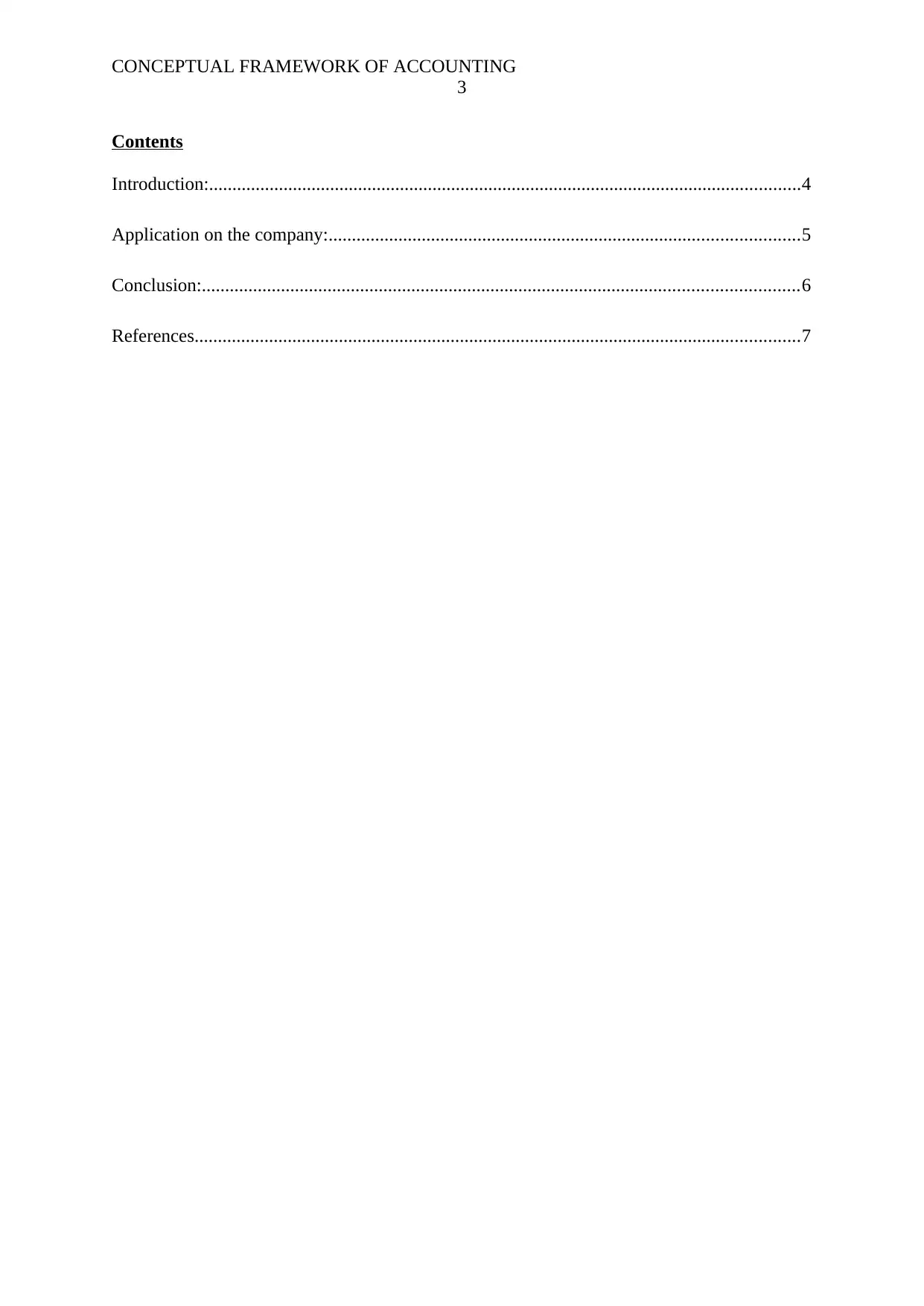
CONCEPTUAL FRAMEWORK OF ACCOUNTING
3
Contents
Introduction:...............................................................................................................................4
Application on the company:.....................................................................................................5
Conclusion:................................................................................................................................6
References..................................................................................................................................7
3
Contents
Introduction:...............................................................................................................................4
Application on the company:.....................................................................................................5
Conclusion:................................................................................................................................6
References..................................................................................................................................7
⊘ This is a preview!⊘
Do you want full access?
Subscribe today to unlock all pages.

Trusted by 1+ million students worldwide
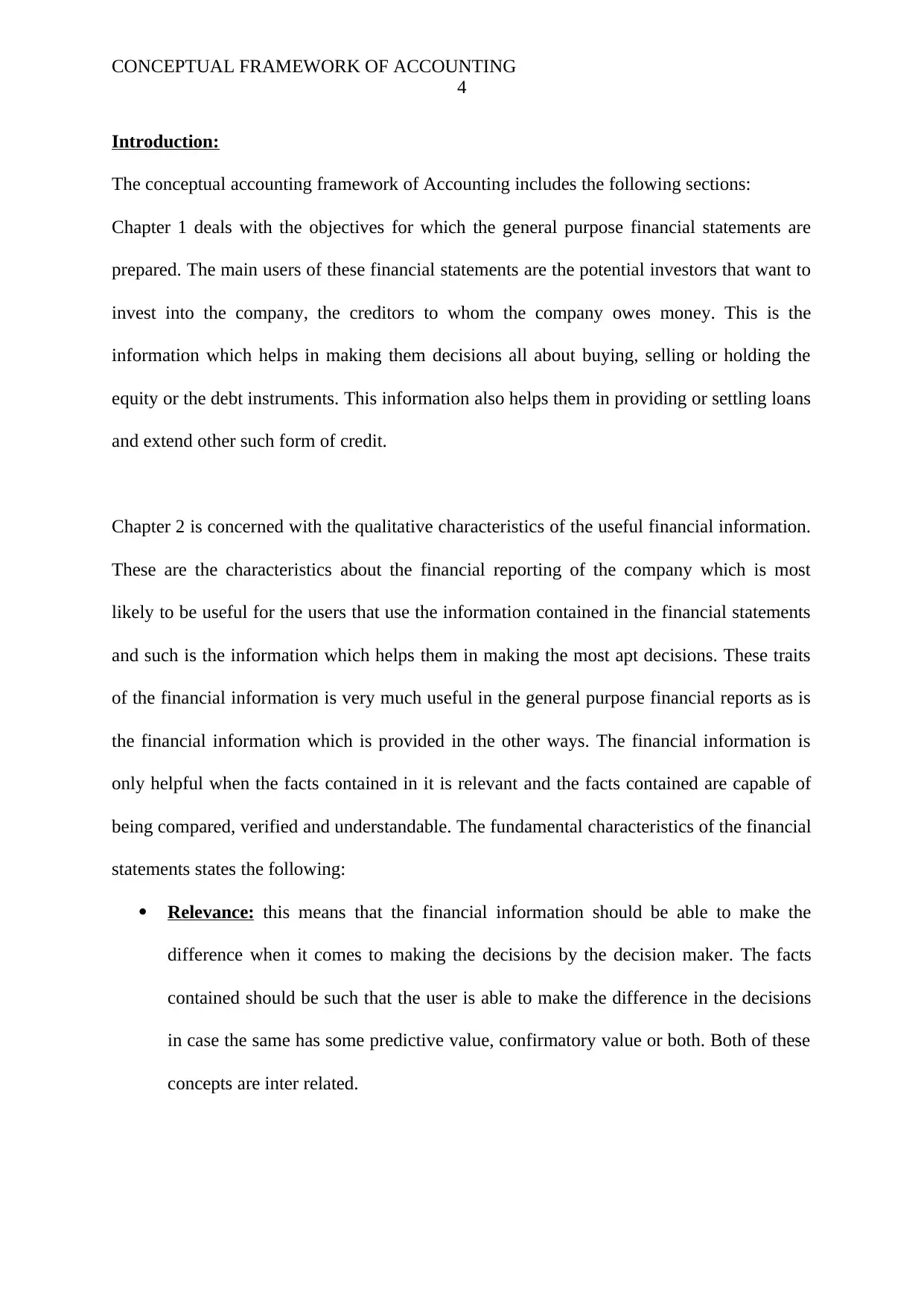
CONCEPTUAL FRAMEWORK OF ACCOUNTING
4
Introduction:
The conceptual accounting framework of Accounting includes the following sections:
Chapter 1 deals with the objectives for which the general purpose financial statements are
prepared. The main users of these financial statements are the potential investors that want to
invest into the company, the creditors to whom the company owes money. This is the
information which helps in making them decisions all about buying, selling or holding the
equity or the debt instruments. This information also helps them in providing or settling loans
and extend other such form of credit.
Chapter 2 is concerned with the qualitative characteristics of the useful financial information.
These are the characteristics about the financial reporting of the company which is most
likely to be useful for the users that use the information contained in the financial statements
and such is the information which helps them in making the most apt decisions. These traits
of the financial information is very much useful in the general purpose financial reports as is
the financial information which is provided in the other ways. The financial information is
only helpful when the facts contained in it is relevant and the facts contained are capable of
being compared, verified and understandable. The fundamental characteristics of the financial
statements states the following:
Relevance: this means that the financial information should be able to make the
difference when it comes to making the decisions by the decision maker. The facts
contained should be such that the user is able to make the difference in the decisions
in case the same has some predictive value, confirmatory value or both. Both of these
concepts are inter related.
4
Introduction:
The conceptual accounting framework of Accounting includes the following sections:
Chapter 1 deals with the objectives for which the general purpose financial statements are
prepared. The main users of these financial statements are the potential investors that want to
invest into the company, the creditors to whom the company owes money. This is the
information which helps in making them decisions all about buying, selling or holding the
equity or the debt instruments. This information also helps them in providing or settling loans
and extend other such form of credit.
Chapter 2 is concerned with the qualitative characteristics of the useful financial information.
These are the characteristics about the financial reporting of the company which is most
likely to be useful for the users that use the information contained in the financial statements
and such is the information which helps them in making the most apt decisions. These traits
of the financial information is very much useful in the general purpose financial reports as is
the financial information which is provided in the other ways. The financial information is
only helpful when the facts contained in it is relevant and the facts contained are capable of
being compared, verified and understandable. The fundamental characteristics of the financial
statements states the following:
Relevance: this means that the financial information should be able to make the
difference when it comes to making the decisions by the decision maker. The facts
contained should be such that the user is able to make the difference in the decisions
in case the same has some predictive value, confirmatory value or both. Both of these
concepts are inter related.
Paraphrase This Document
Need a fresh take? Get an instant paraphrase of this document with our AI Paraphraser
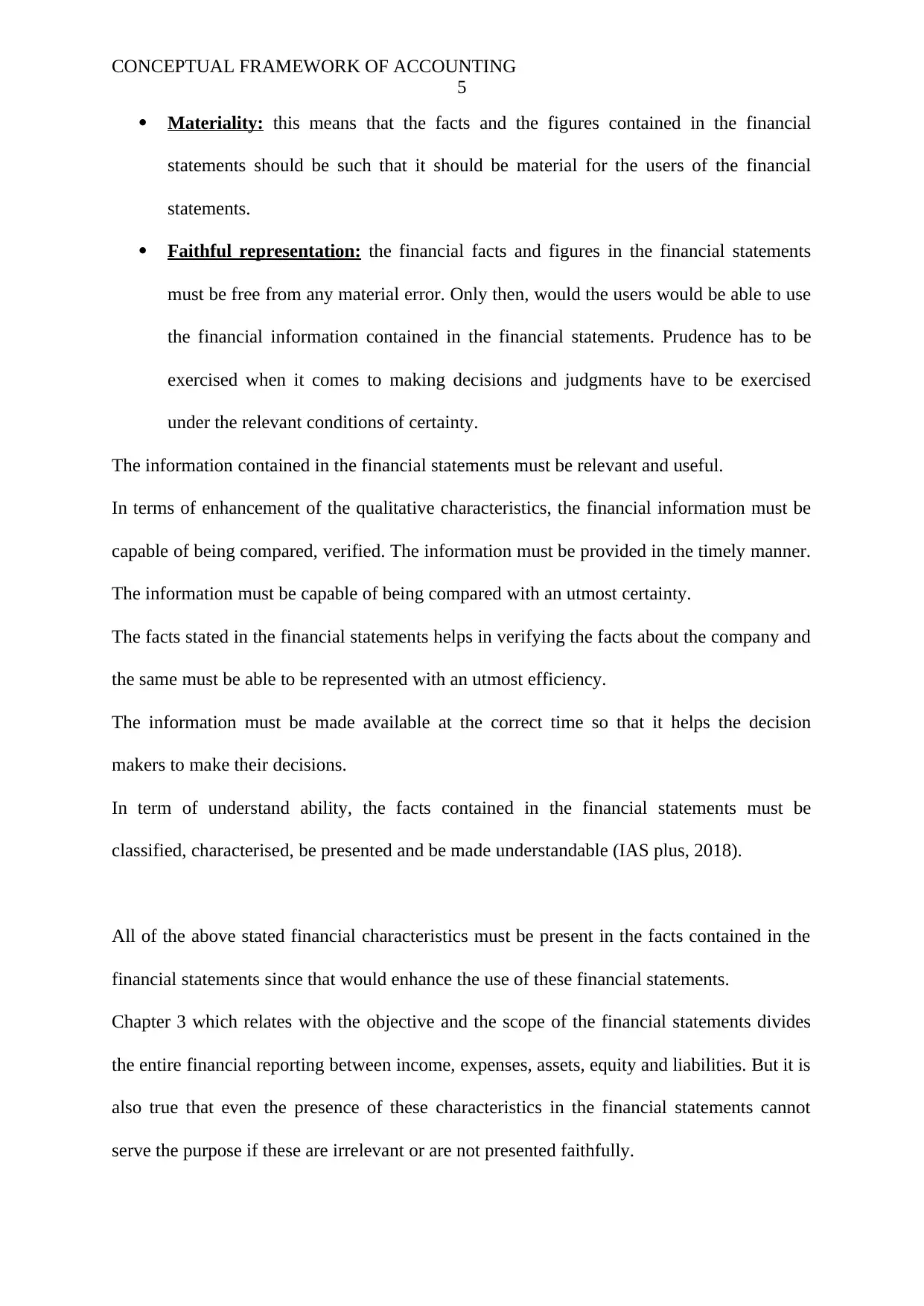
CONCEPTUAL FRAMEWORK OF ACCOUNTING
5
Materiality: this means that the facts and the figures contained in the financial
statements should be such that it should be material for the users of the financial
statements.
Faithful representation: the financial facts and figures in the financial statements
must be free from any material error. Only then, would the users would be able to use
the financial information contained in the financial statements. Prudence has to be
exercised when it comes to making decisions and judgments have to be exercised
under the relevant conditions of certainty.
The information contained in the financial statements must be relevant and useful.
In terms of enhancement of the qualitative characteristics, the financial information must be
capable of being compared, verified. The information must be provided in the timely manner.
The information must be capable of being compared with an utmost certainty.
The facts stated in the financial statements helps in verifying the facts about the company and
the same must be able to be represented with an utmost efficiency.
The information must be made available at the correct time so that it helps the decision
makers to make their decisions.
In term of understand ability, the facts contained in the financial statements must be
classified, characterised, be presented and be made understandable (IAS plus, 2018).
All of the above stated financial characteristics must be present in the facts contained in the
financial statements since that would enhance the use of these financial statements.
Chapter 3 which relates with the objective and the scope of the financial statements divides
the entire financial reporting between income, expenses, assets, equity and liabilities. But it is
also true that even the presence of these characteristics in the financial statements cannot
serve the purpose if these are irrelevant or are not presented faithfully.
5
Materiality: this means that the facts and the figures contained in the financial
statements should be such that it should be material for the users of the financial
statements.
Faithful representation: the financial facts and figures in the financial statements
must be free from any material error. Only then, would the users would be able to use
the financial information contained in the financial statements. Prudence has to be
exercised when it comes to making decisions and judgments have to be exercised
under the relevant conditions of certainty.
The information contained in the financial statements must be relevant and useful.
In terms of enhancement of the qualitative characteristics, the financial information must be
capable of being compared, verified. The information must be provided in the timely manner.
The information must be capable of being compared with an utmost certainty.
The facts stated in the financial statements helps in verifying the facts about the company and
the same must be able to be represented with an utmost efficiency.
The information must be made available at the correct time so that it helps the decision
makers to make their decisions.
In term of understand ability, the facts contained in the financial statements must be
classified, characterised, be presented and be made understandable (IAS plus, 2018).
All of the above stated financial characteristics must be present in the facts contained in the
financial statements since that would enhance the use of these financial statements.
Chapter 3 which relates with the objective and the scope of the financial statements divides
the entire financial reporting between income, expenses, assets, equity and liabilities. But it is
also true that even the presence of these characteristics in the financial statements cannot
serve the purpose if these are irrelevant or are not presented faithfully.
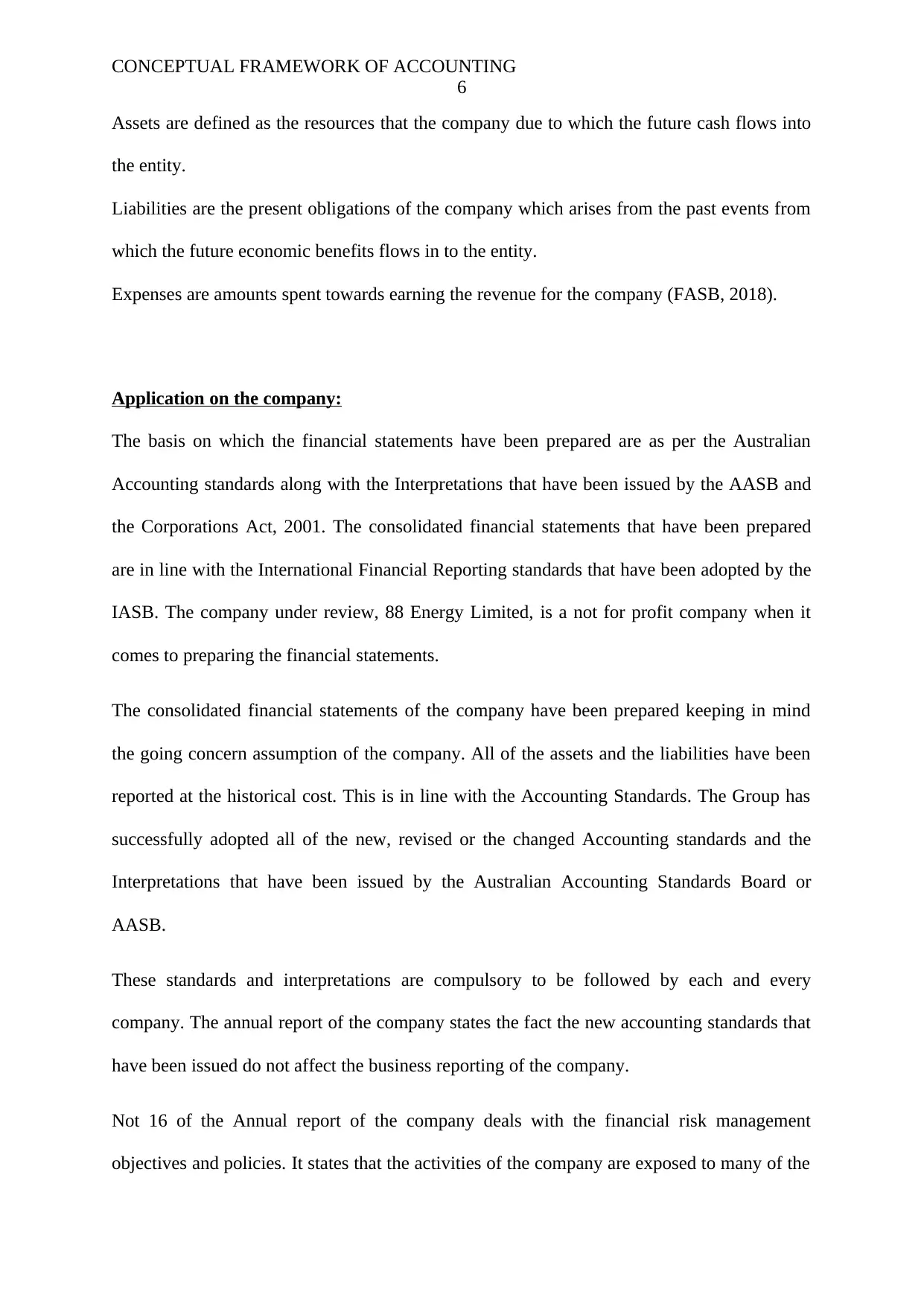
CONCEPTUAL FRAMEWORK OF ACCOUNTING
6
Assets are defined as the resources that the company due to which the future cash flows into
the entity.
Liabilities are the present obligations of the company which arises from the past events from
which the future economic benefits flows in to the entity.
Expenses are amounts spent towards earning the revenue for the company (FASB, 2018).
Application on the company:
The basis on which the financial statements have been prepared are as per the Australian
Accounting standards along with the Interpretations that have been issued by the AASB and
the Corporations Act, 2001. The consolidated financial statements that have been prepared
are in line with the International Financial Reporting standards that have been adopted by the
IASB. The company under review, 88 Energy Limited, is a not for profit company when it
comes to preparing the financial statements.
The consolidated financial statements of the company have been prepared keeping in mind
the going concern assumption of the company. All of the assets and the liabilities have been
reported at the historical cost. This is in line with the Accounting Standards. The Group has
successfully adopted all of the new, revised or the changed Accounting standards and the
Interpretations that have been issued by the Australian Accounting Standards Board or
AASB.
These standards and interpretations are compulsory to be followed by each and every
company. The annual report of the company states the fact the new accounting standards that
have been issued do not affect the business reporting of the company.
Not 16 of the Annual report of the company deals with the financial risk management
objectives and policies. It states that the activities of the company are exposed to many of the
6
Assets are defined as the resources that the company due to which the future cash flows into
the entity.
Liabilities are the present obligations of the company which arises from the past events from
which the future economic benefits flows in to the entity.
Expenses are amounts spent towards earning the revenue for the company (FASB, 2018).
Application on the company:
The basis on which the financial statements have been prepared are as per the Australian
Accounting standards along with the Interpretations that have been issued by the AASB and
the Corporations Act, 2001. The consolidated financial statements that have been prepared
are in line with the International Financial Reporting standards that have been adopted by the
IASB. The company under review, 88 Energy Limited, is a not for profit company when it
comes to preparing the financial statements.
The consolidated financial statements of the company have been prepared keeping in mind
the going concern assumption of the company. All of the assets and the liabilities have been
reported at the historical cost. This is in line with the Accounting Standards. The Group has
successfully adopted all of the new, revised or the changed Accounting standards and the
Interpretations that have been issued by the Australian Accounting Standards Board or
AASB.
These standards and interpretations are compulsory to be followed by each and every
company. The annual report of the company states the fact the new accounting standards that
have been issued do not affect the business reporting of the company.
Not 16 of the Annual report of the company deals with the financial risk management
objectives and policies. It states that the activities of the company are exposed to many of the
⊘ This is a preview!⊘
Do you want full access?
Subscribe today to unlock all pages.

Trusted by 1+ million students worldwide
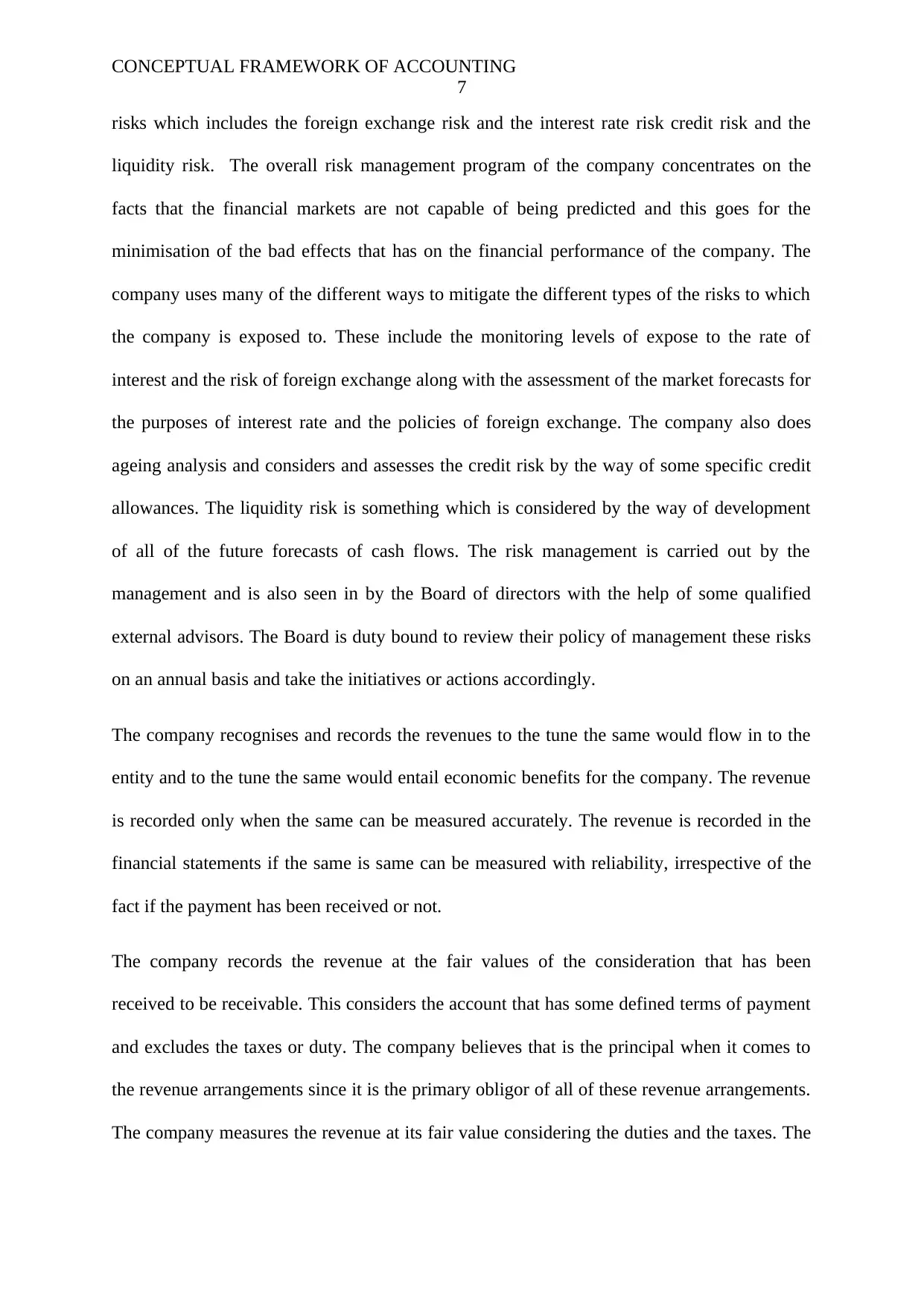
CONCEPTUAL FRAMEWORK OF ACCOUNTING
7
risks which includes the foreign exchange risk and the interest rate risk credit risk and the
liquidity risk. The overall risk management program of the company concentrates on the
facts that the financial markets are not capable of being predicted and this goes for the
minimisation of the bad effects that has on the financial performance of the company. The
company uses many of the different ways to mitigate the different types of the risks to which
the company is exposed to. These include the monitoring levels of expose to the rate of
interest and the risk of foreign exchange along with the assessment of the market forecasts for
the purposes of interest rate and the policies of foreign exchange. The company also does
ageing analysis and considers and assesses the credit risk by the way of some specific credit
allowances. The liquidity risk is something which is considered by the way of development
of all of the future forecasts of cash flows. The risk management is carried out by the
management and is also seen in by the Board of directors with the help of some qualified
external advisors. The Board is duty bound to review their policy of management these risks
on an annual basis and take the initiatives or actions accordingly.
The company recognises and records the revenues to the tune the same would flow in to the
entity and to the tune the same would entail economic benefits for the company. The revenue
is recorded only when the same can be measured accurately. The revenue is recorded in the
financial statements if the same is same can be measured with reliability, irrespective of the
fact if the payment has been received or not.
The company records the revenue at the fair values of the consideration that has been
received to be receivable. This considers the account that has some defined terms of payment
and excludes the taxes or duty. The company believes that is the principal when it comes to
the revenue arrangements since it is the primary obligor of all of these revenue arrangements.
The company measures the revenue at its fair value considering the duties and the taxes. The
7
risks which includes the foreign exchange risk and the interest rate risk credit risk and the
liquidity risk. The overall risk management program of the company concentrates on the
facts that the financial markets are not capable of being predicted and this goes for the
minimisation of the bad effects that has on the financial performance of the company. The
company uses many of the different ways to mitigate the different types of the risks to which
the company is exposed to. These include the monitoring levels of expose to the rate of
interest and the risk of foreign exchange along with the assessment of the market forecasts for
the purposes of interest rate and the policies of foreign exchange. The company also does
ageing analysis and considers and assesses the credit risk by the way of some specific credit
allowances. The liquidity risk is something which is considered by the way of development
of all of the future forecasts of cash flows. The risk management is carried out by the
management and is also seen in by the Board of directors with the help of some qualified
external advisors. The Board is duty bound to review their policy of management these risks
on an annual basis and take the initiatives or actions accordingly.
The company recognises and records the revenues to the tune the same would flow in to the
entity and to the tune the same would entail economic benefits for the company. The revenue
is recorded only when the same can be measured accurately. The revenue is recorded in the
financial statements if the same is same can be measured with reliability, irrespective of the
fact if the payment has been received or not.
The company records the revenue at the fair values of the consideration that has been
received to be receivable. This considers the account that has some defined terms of payment
and excludes the taxes or duty. The company believes that is the principal when it comes to
the revenue arrangements since it is the primary obligor of all of these revenue arrangements.
The company measures the revenue at its fair value considering the duties and the taxes. The
Paraphrase This Document
Need a fresh take? Get an instant paraphrase of this document with our AI Paraphraser
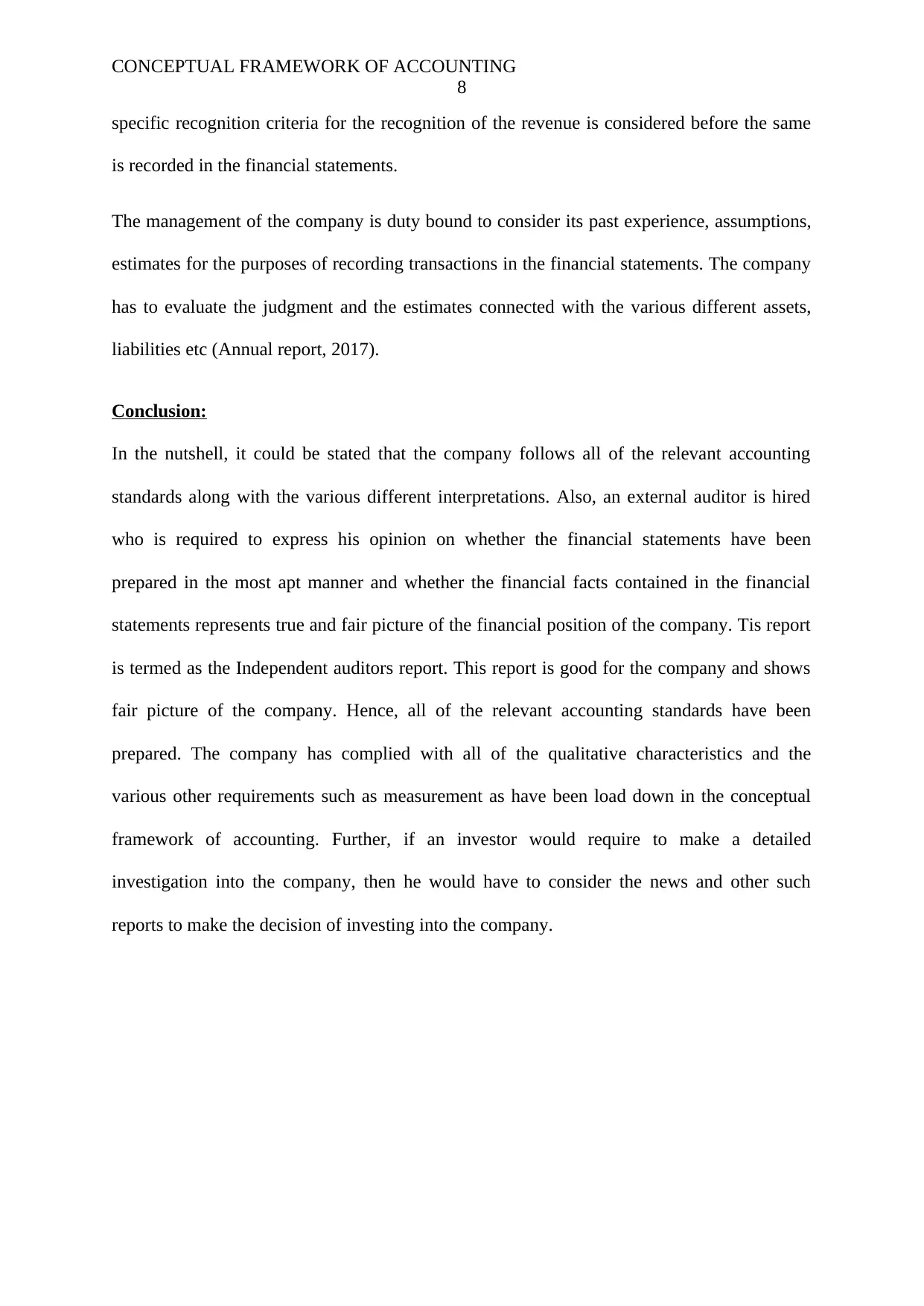
CONCEPTUAL FRAMEWORK OF ACCOUNTING
8
specific recognition criteria for the recognition of the revenue is considered before the same
is recorded in the financial statements.
The management of the company is duty bound to consider its past experience, assumptions,
estimates for the purposes of recording transactions in the financial statements. The company
has to evaluate the judgment and the estimates connected with the various different assets,
liabilities etc (Annual report, 2017).
Conclusion:
In the nutshell, it could be stated that the company follows all of the relevant accounting
standards along with the various different interpretations. Also, an external auditor is hired
who is required to express his opinion on whether the financial statements have been
prepared in the most apt manner and whether the financial facts contained in the financial
statements represents true and fair picture of the financial position of the company. Tis report
is termed as the Independent auditors report. This report is good for the company and shows
fair picture of the company. Hence, all of the relevant accounting standards have been
prepared. The company has complied with all of the qualitative characteristics and the
various other requirements such as measurement as have been load down in the conceptual
framework of accounting. Further, if an investor would require to make a detailed
investigation into the company, then he would have to consider the news and other such
reports to make the decision of investing into the company.
8
specific recognition criteria for the recognition of the revenue is considered before the same
is recorded in the financial statements.
The management of the company is duty bound to consider its past experience, assumptions,
estimates for the purposes of recording transactions in the financial statements. The company
has to evaluate the judgment and the estimates connected with the various different assets,
liabilities etc (Annual report, 2017).
Conclusion:
In the nutshell, it could be stated that the company follows all of the relevant accounting
standards along with the various different interpretations. Also, an external auditor is hired
who is required to express his opinion on whether the financial statements have been
prepared in the most apt manner and whether the financial facts contained in the financial
statements represents true and fair picture of the financial position of the company. Tis report
is termed as the Independent auditors report. This report is good for the company and shows
fair picture of the company. Hence, all of the relevant accounting standards have been
prepared. The company has complied with all of the qualitative characteristics and the
various other requirements such as measurement as have been load down in the conceptual
framework of accounting. Further, if an investor would require to make a detailed
investigation into the company, then he would have to consider the news and other such
reports to make the decision of investing into the company.
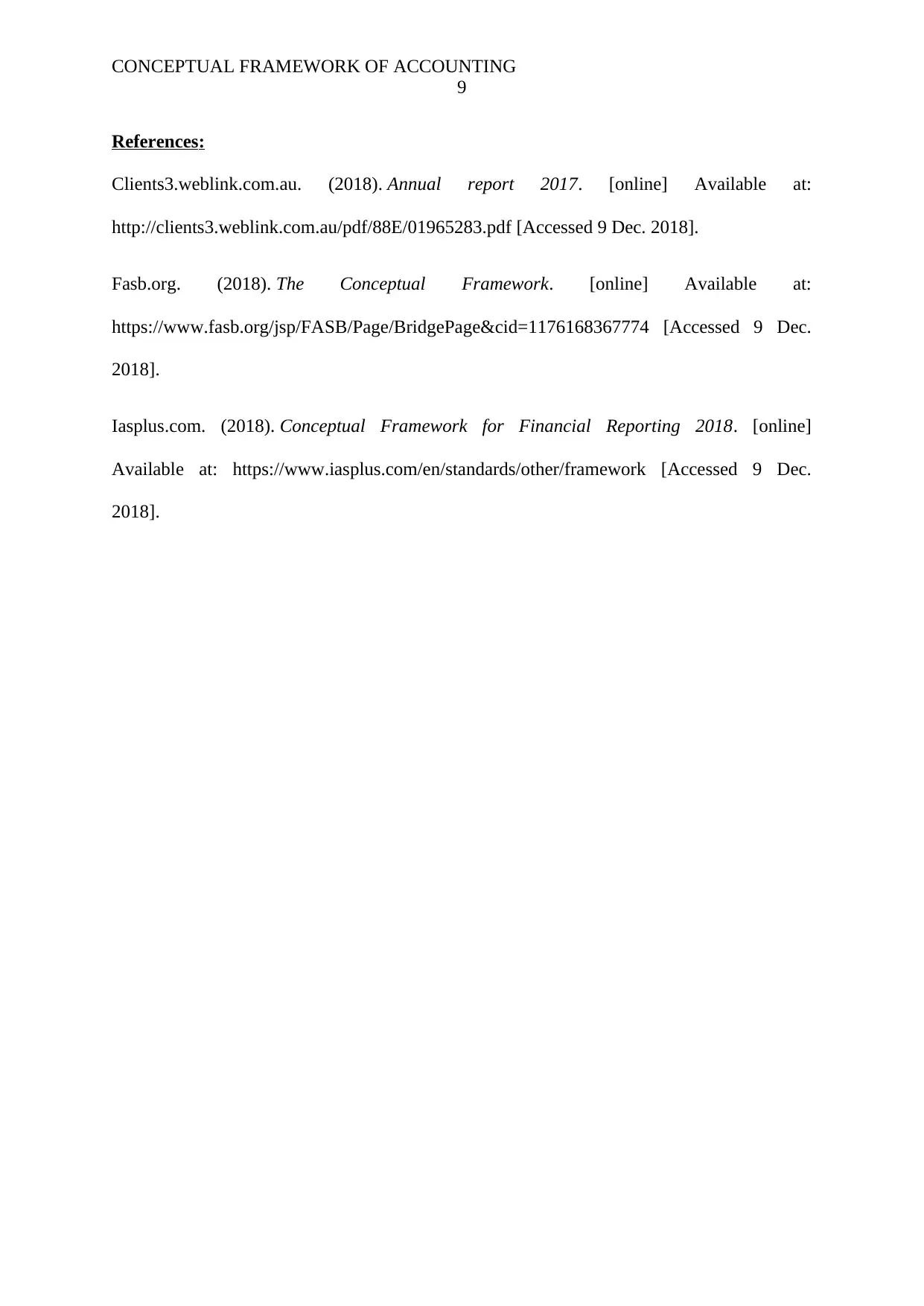
CONCEPTUAL FRAMEWORK OF ACCOUNTING
9
References:
Clients3.weblink.com.au. (2018). Annual report 2017. [online] Available at:
http://clients3.weblink.com.au/pdf/88E/01965283.pdf [Accessed 9 Dec. 2018].
Fasb.org. (2018). The Conceptual Framework. [online] Available at:
https://www.fasb.org/jsp/FASB/Page/BridgePage&cid=1176168367774 [Accessed 9 Dec.
2018].
Iasplus.com. (2018). Conceptual Framework for Financial Reporting 2018. [online]
Available at: https://www.iasplus.com/en/standards/other/framework [Accessed 9 Dec.
2018].
9
References:
Clients3.weblink.com.au. (2018). Annual report 2017. [online] Available at:
http://clients3.weblink.com.au/pdf/88E/01965283.pdf [Accessed 9 Dec. 2018].
Fasb.org. (2018). The Conceptual Framework. [online] Available at:
https://www.fasb.org/jsp/FASB/Page/BridgePage&cid=1176168367774 [Accessed 9 Dec.
2018].
Iasplus.com. (2018). Conceptual Framework for Financial Reporting 2018. [online]
Available at: https://www.iasplus.com/en/standards/other/framework [Accessed 9 Dec.
2018].
⊘ This is a preview!⊘
Do you want full access?
Subscribe today to unlock all pages.

Trusted by 1+ million students worldwide
1 out of 9
Related Documents
Your All-in-One AI-Powered Toolkit for Academic Success.
+13062052269
info@desklib.com
Available 24*7 on WhatsApp / Email
![[object Object]](/_next/static/media/star-bottom.7253800d.svg)
Unlock your academic potential
Copyright © 2020–2025 A2Z Services. All Rights Reserved. Developed and managed by ZUCOL.





